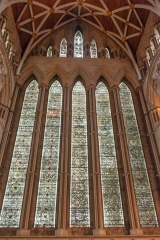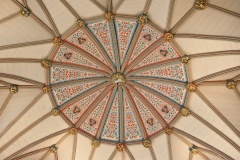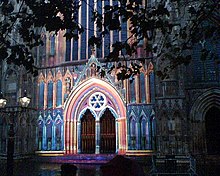This multi cache will take you all around the exterior of the Minster. I would encourage anyone to visit inside and would have put some of the clues to the coordinates in there but the charge is more than I would be happy to have anyone paying to find a cache.
The Cathedral and Metropolitical Church of St Peter in York

York Minster west front
This church was itself rebuilt by St. Wilfrid around 670, but it was Egbert (732-766), the first recogised Archbishop of York, who made the cathedral school and library the envy of Europe. The Minster Church burned down in 741, but it was replaced by a glorious new church containing no less than 30 altars.
The next few centuries were ones of turmoil in York, as the city was held by the Danes, Saxons, Norse, and English in turns. The pagan invaders left the church alone, and one Danish king, Guthfrith, converted to Christianity and was buried in the Minster in 895.
A subsequent archbishop, Ealdred, was responsible for crowning William the Conqueror in London. Ealdred was buried in the Minster in 1069, and just a few days later the church was badly damaged in a struggle between the Danes, Normans, and Saxons.

The Five Sisters window
In 1137 the Minster suffered severe fire damage yet again. The choir and crypt were rebuilt beginning in 1154, and a large chapel dedicated to St. Sepulchre was added to the nave. But by this time the Norman Minster was decidedly out of step with the new Gothic fashion then sweeping Europe.
A slow makeover of the Minster began in 1220 with the South Transept, followed by the North Transept. The styles of these transepts are quite unique, though they were built but a few years apart. The North Transept is famous for its "Five Sisters"; five graceful lancet windows topped by five smaller gabled lancets. A great central tower was built at the same period as the transepts, but this collapsed in 1407. The delicate Chapter House, where the day to day business of the Minster was run, was begun in about 1260. It is a superb example of the Gothic Decorated style which was then in vogue.

The Chapter House vaulted ceiling
The old Norman nave was rebuilt, beginning around 1280. The new nave was exactly twice as wide as the old, making it the widest in Europe and the second tallest (after Westminster Abbey) in England. The last surviving part of the Norman cathedral, the choir, was rebuilt in 1395.
Richard Scrope was appointed Archbishop by Richard II in 1398. Scrope then rebelled against Richard's successor, Henry IV in 1405, but he was captured and executed before the walls of York.
A new central tower was begun in 1420 to replace the one which collapsed in 1407 (see above). In 1472 the work of rebuilding the minster was declared complete and the Minster was rededicated. York Minster suffered heavily duriing the English Reformation and its aftermath; the chantry chapels and altars were torn down under Edward VI, and much of the cathedral plate was lost.
But this was nothing compared to the depradations suffered under Elizabeth I. The interior of the Minster was stripped of its tombs, funereal brasses, memorials, altars, vestments, coats of arms, and stained-glass portraits.

The choir screen
But the building was not safe from the onslaught of changing fashion. In 1730 Lord Burlington designed a new floor for the Minster in the neo-classical Palladian style. The new marble floor required the destruction of every tomb left in the nave and many in the transepts and choir as well.
The building suffered from further fires in the Victorian period, and the ravages of time have neccessitated ongoing repair work during the 20th century, but York Minster retains the allure of its rich history and marvellous architectural heritage.
On 9 July 1984, a fire believed to have been caused by a lightning strike destroyed the roof in the south transept, and around £2.5 million was spent on repairs. Restoration work was completed in 1988, and included new roof bosses to designs which had won a competition organised by BBC Television's Blue Peter programme. In 2007 renovation began on the east front, including the Great East Window, at an estimated cost of £23 million.

The West Door, illuminated in December 2005
In November 2002, York Minster was illuminated in colour, devised by York-born Mark Brayshaw, for the first time in its history. The occasion was televised live on the BBC1 Look North programme. Similar illuminations have been projected over the Christmas period in subsequent years.
York Minster was also artistically illuminated on 5 November 2005, celebrating the 400th anniversary of the foiling of York-born Guy Fawkes' gunpowder plot. This was done by Patrice Warrener using his unique "chromolithe" technique with which he 'paints' with light, picking out sculpted architectural details.
In October 2010, York Minster's South transept was selected for 'Rose' a son et lumiere, created by international artists Ross Ashton and Karen Monid, which lit up the entire exterior of the South transept of the Minster and illuminated the Rose Window. There were also satellite illuminate events in Dean's Park.
Coming To York
York is superbly serviced by the national rail network, being a key station on the East Coast Main Line as well as having direct trains to the South West of England and the Far North of Scotland.
There are several pay and display car parks within the city centre. My preferred choice of transport into the city however is the excellent Park and Ride bus services, that operate from several areas of the city and are clearly sign posted from the A64 and the A1237
You ought to allow a good half hour to wonder around the Minster to collect the clues and due to the high cache density already in York, the final is a little under a mile away from the starting position. The walk will take you past some excellent caches and amazing historical sites and will take you to one of the more peaceful bits of a bustling city.
The Coordinates
In order to find the cache you will need to do a full circle of the Minster.
At the starting coordinates you will find a stone in the floor about the restoration of the West doorway. The year was 199A
At stage 1 you will find a stunning 3D sculpture of the city. Find the Minster and the number it is given is B.
At stage 2 is a lampost. How many lamps does it hold? The answer is C.
At stage 3 is a plaque to Jaques Sterne. He lived here from 17DE to 17FG.
At stage 4 you will find lions holding a column. How many lions? The answer is H.
At stage 5 is a noticeboard with another map of the area. Look at the road side side of the sign. What number is the Minster? Add the two together to get I.
At stage 6 is a Roman column. What year was the foundation of York by the Romans? It was AD JK.
At stage 7 is a statue of Constantine. He was proclaimed Roman Emperor in York in what year? Add the 3 numbers together and that gives L.
The final coordinates are N 53° F7.1(G-L)(D+B) W 001° (C+E).6AH
And finally
This page looks reasonably pretty because a good chunk of it has been borrowed from an excellent online resource, http://www.britainexpress.com and the Minster's page on Wikipedia.
Please remember that when we trade items we should be leaving things of equal or greater amounts. To help some folk I have left some price labels on  It would be disappointing to come back to the cache and find some feathers, beer bottle tops and stones.
It would be disappointing to come back to the cache and find some feathers, beer bottle tops and stones.
I hope you enjoy my cache.
**************************************
For full information on how you can expand the Church Micro series by sadexploration please read the Place your own Church Micro page before you contact him at churchmicro@gmail.com.
See also the Church Micro Statistics and Home pages for further information about the series.
*************************************
